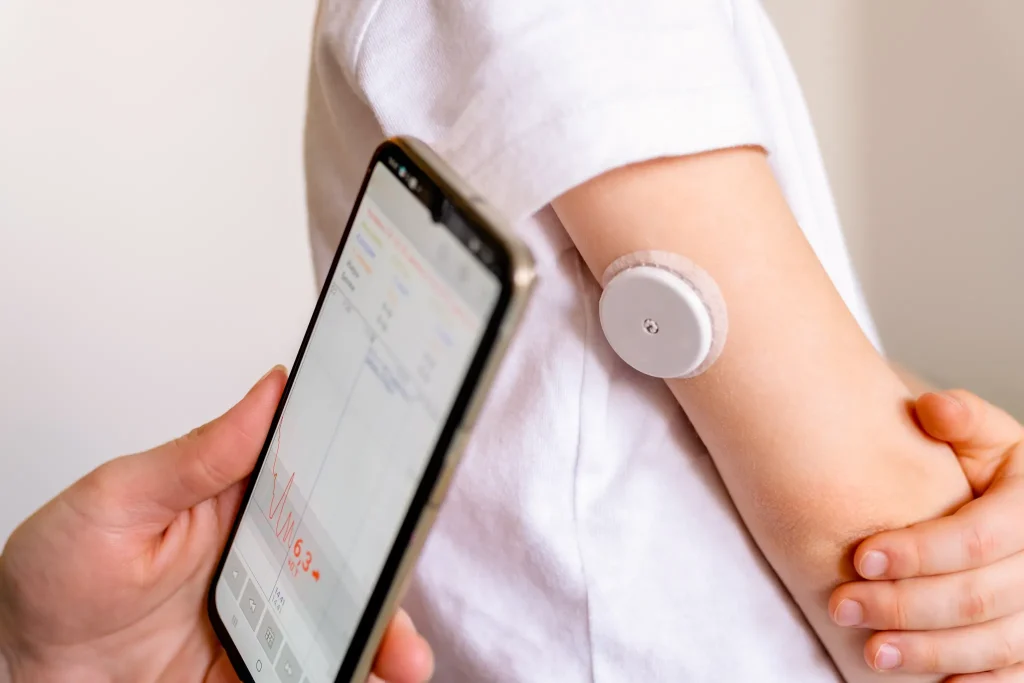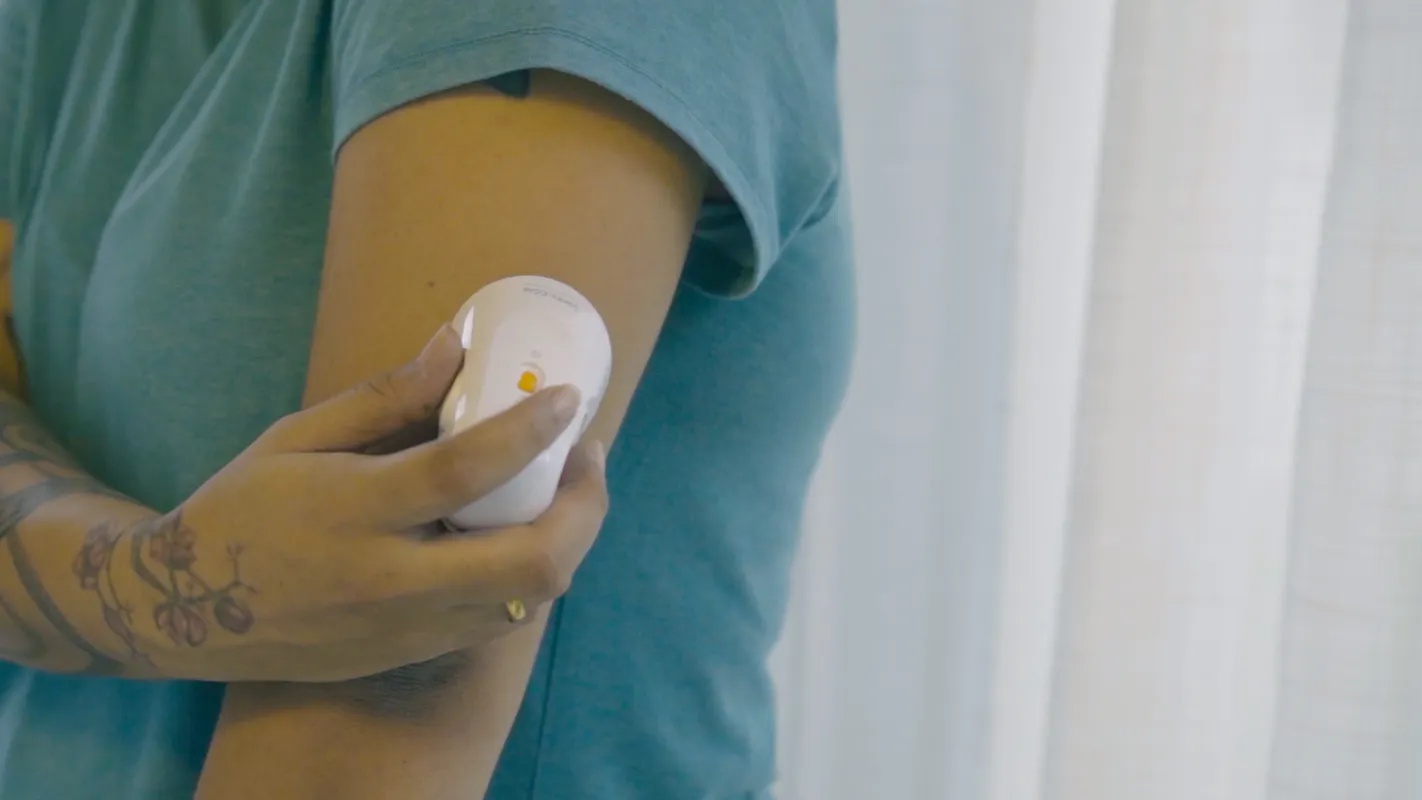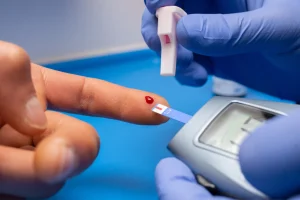A Continuous Glucose Monitor (CGM) provides effortless blood sugar tracking at home. It is a small, wearable device that tracks your glucose levels continuously, providing real-time insights without the need for multiple finger pricks. It is easy to use and cost-effective.
Why Sugar Testing at Home Matters?
Monitoring your blood sugar isn’t just for managing diabetes. Whether you’re dealing with Type 2 diabetes, prediabetes, PCOS, or simply aiming to optimise your fitness and energy levels, testing at home can help you:
- Catch early signs of blood sugar issues.
- Understand how food, exercise, and sleep affect your glucose levels.
- Make daily choices that support long-term metabolic health.
While traditional monitoring relied on finger pricks, Continuous Glucose Monitors have transformed the process, making it easier, virtually painless, and far more insightful.
⇒ ⇒ Read More – Are Bananas Good for Diabetes?
What Is a CGM & How Does It Work?
A Continuous Glucose Monitor (CGM) is a small sensor placed under your skin (typically on the arm or abdomen). It reads glucose levels in the interstitial fluid (the fluid surrounding cells) every few minutes and wirelessly sends data to your phone or a reader.
- Sensor: Inserted under the skin to measure glucose in interstitial fluid.
- Transmitter: Sends glucose readings to your device.
- App or Reader: Displays real-time glucose levels, trends, and alerts.
Unlike glucometers that provide single-point readings, CGMs deliver continuous data, letting you see how glucose levels change throughout the day and night.
⇒ ⇒ Read More – Metabolism vs. Digestion: What’s the Difference & How to Improve Both
Why Use a CGM?

- For diabetes management: CGMs alert you in advance to potentially dangerous glucose highs or lows, helping you take timely action.
- For prevention and wellness tracking: Even if you’re not diabetic, a CGM can reveal how your body responds to meals, movement, and stress, though experts caution that for healthy individuals, benefits may be limited and sometimes anxiety-inducing. (diaTribe)
⇒ ⇒ Read More – Is Papaya Good for Diabetes? Benefits, How to Eat It and Smart Alternatives
How to Do a Sugar Test at Home with a CGM?
Here is a step-by-step guide:
1. Get a CGM device
- In India, CGMs are available through pharmacies and health programs. You can buy GoodFlip’s best smart Bluetooth-enabled CGM for accurate readings.
2. Apply the sensor
- Select a clean spot on your upper arm or abdomen.
- Use the device’s applicator to insert the filament quickly and mostly painlessly.
- Secure it with the provided adhesive.
3. Start the sensor
- Activate it through the app or reader.
- Most devices have a 1–2 hour warm-up period before readings begin.
4. Track your readings
- Wear the sensor continuously (typically 10–14 days).
- Open your app to monitor glucose anytime.
- Track key readings such as:
– Fasting (morning)
– Pre-meal
– 2 hours post-meal
– Before bed
Understanding CGM Results
The following ranges are based on data from healthy, non-diabetic adults.
| Time of Measurement | Normal Range (mg/dL) |
|---|---|
| Fasting (morning) | 70-99 |
| Before meals | 70–99 |
| 2 hours after meals | <140 |
| CGM daily average | ~90–100 |
| Insight | Range (mg/dL) |
|---|---|
| Very low (below-range) | Less than (<) 54 |
| Low (below-range) | 54 to 69 |
| In-range | 70 to 180 |
| High (above-range) | 181 to 250 |
| Very high (above-range) | Greater than (>) 250 |
CGMs also track Time In Range (TIR): it’s the percentage of time you spend within target range, typically 70–180 mg/dL, and experts suggest aiming for at least 70% TIR.
⇒ ⇒ Read More – What are the 7 Signs of Slow Metabolism in Females?
Using CGM to Fix Lifestyle and Sugar Spikes
Continuous Glucose Monitors (CGMs) do more than track blood sugar. They give real-time feedback that helps people make lifestyle changes, cut down on sugar spikes, and feel more in control of their health.
1. Real-time insights for smarter choices
CGMs show how your glucose levels rise and fall throughout the day. You can instantly see the effect of certain meals, stress, sleep, or exercise.
This makes it easier to spot which foods trigger spikes and what habits might be holding you back. With that knowledge, you can adjust portion sizes, meal timings, or food choices to keep your glucose steady.
2. Building healthier habits
When you can see how quickly your glucose changes, the connection between your daily actions and your health becomes clear.
This awareness is the foundation of lifestyle medicine nutrition, physical activity, sleep, stress management, and other habits that improve metabolic health. Over time, these changes can even support diabetes remission.
3. Personalized food and activity guidance
CGM data highlights how your body responds to specific meals. It can guide you toward better food combinations and smarter timing.
It can also nudge you to move more, like taking a short walk after a heavy meal, or adjusting your workouts to improve glucose use.
4. Supporting medication adjustments
For people taking insulin or other medications, CGMs are a safety net. The data helps doctors fine-tune doses, lowering the risk of highs and lows.
As glucose control improves with lifestyle changes, many people can also reduce their medication load.
5. Better long-term outcomes
Research shows that CGM users often see lower HbA1c levels, more time spent in the target glucose range, fewer dangerous spikes, and even improvements in weight and blood pressure.
The constant feedback makes it easier for both patients and doctors to keep glucose under control and prevent future complications.
⇒ ⇒ Read More – Fast vs. Slow Metabolism: What’s the Difference & Which is Better for You?
Tips to Improve CGM Accuracy
The International Diabetes Federation gives the following ways to improve CGM Accuracy:
- Place the sensor correctly: Follow the guidelines: typically, arm or abdomen spots yield the best results.
- Avoid pressure on the sensor: Lying or pressing on it can cause incorrect low readings (pressure-induced artifacts).
- Calibrate if needed: Some CGMs require periodic finger-prick confirmation.
- Tag your activities: Logging meals, workouts, and stress helps provide context to glucose trends.
- Check during steady times: Rapid changes can introduce slight delays or inaccuracies due to the interstitial fluid lag.
⇒ ⇒ Read More – How to Check if Your Metabolism is Damaged: Symptoms, Causes & Recovery (2025 Guide)
Buy the Best Smart CGM Device in India
The GoodFlip CGM: Offers glucose tracking and personalized diet, exercise, and lifestyle plans to fix metabolism, sugar spikes, and diabetes.
GoodFlip CGM is India’s first Bluetooth-enabled CGM, delivering glucose data every 3 minutes, no scanning needed.
With clinical-grade accuracy (MARD 9.07%), 14-day wear, and a reusable transmitter, it’s designed not just for diabetics but for anyone managing PCOS, fatty liver, or insulin resistance, or trying to improve their overall metabolic health.
- Comes with expert diet coaching
- Water-resistant, compact, and painless to use
- Seamlessly syncs with the GoodFlip app
- Metabolic Score-Powered Insights
- Reading Every 3 Minutes
More than just tracking. It’s guidance in real time.
FAQs
1. Which finger is best for traditional blood sugar testing?
The side of the ring or middle finger is typically less painful and still accurate.
2. Can a CGM replace a glucometer?
Yes, in most cases. But it’s good to have a glucometer on hand to confirm readings when needed.
3. What’s considered “normal” glucose for CGM users?
Fasting: 70–99 mg/dL; 2 hours post-meal: <140 mg/dL; daily average: ~90–100 mg/dL.
4. How often should someone with prediabetes wear a CGM?
They might wear it continuously for 2–4 weeks every few months to observe patterns, guided by their healthcare provider.
5. Is CGM suitable for non-diabetics?
While some wellness enthusiasts use CGMs, experts warn of possible anxiety and unclear benefits; professional guidance is advised.









